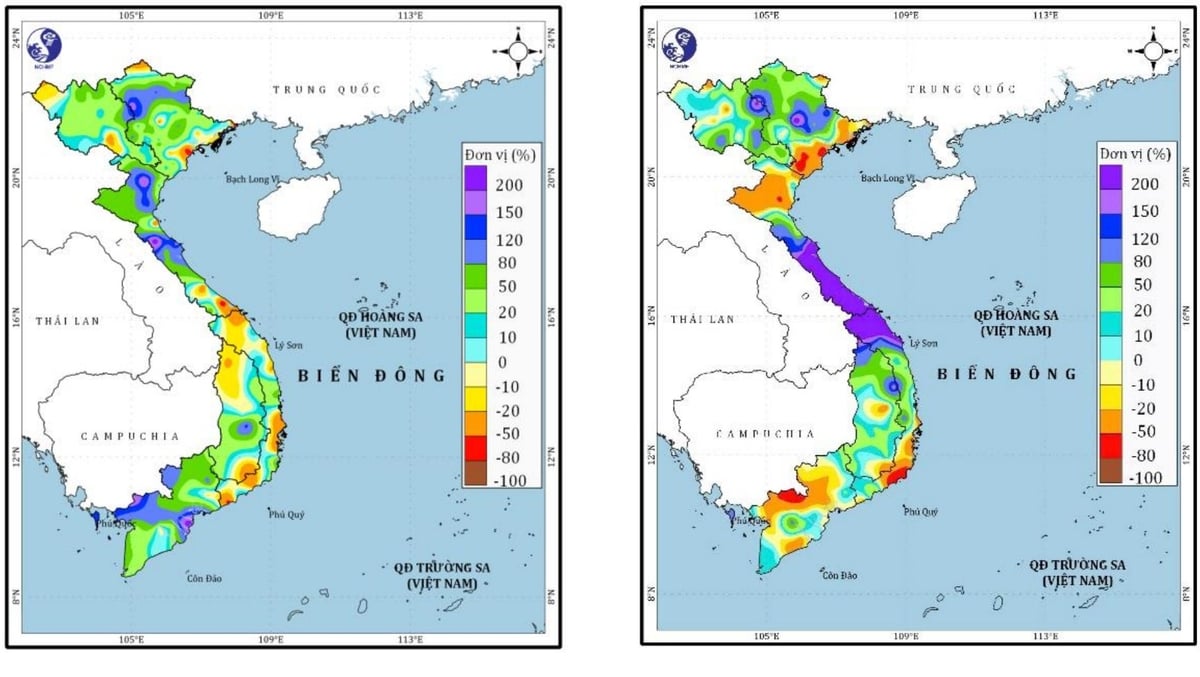September 2, 2025 | 21:44 GMT +7
September 2, 2025 | 21:44 GMT +7
Hotline: 0913.378.918
September 2, 2025 | 21:44 GMT +7
Hotline: 0913.378.918
Regarding the weather from now until the end of the year, intense heat will be concentrated in the northern and central regions until the end of August, then gradually decrease. Additionally, the northern region will experience many days of heavy rain until September, and the rain zone will gradually shift into the central region. Rainfall in some areas may be 10-30% higher than the multi-year average (MUA).
From the beginning of the year until now, Vietnam's weather has been influenced by the neutral ENSO phenomenon, characterized by fewer severe, prolonged heatwaves and more rainfall. Average temperatures in May and June across all regions of the country were generally close to the MUA. Specifically, the area from Thanh Hoa to Ha Tinh in May was typically 0.5-1 degree Celsius lower than the MUA.

Hot weather causes risk of forest fires in many localities. Photo: Le Thao.
The northern region experienced 6 heatwaves, with daily highest temperatures generally ranging from 35-38 degrees Celsius and some places even higher. Notably, despite the past two months being the peak summer season, heatwaves typically lasted only 1-3 days. Only the heatwave on June 1-2 recorded daily highest temperatures of 37-39 degrees Celsius, with some monitoring points reaching 40 degrees Celsius.
In the central region, provinces from Thanh Hoa to Hue and the South Central Coast also recorded 6 heatwaves, each lasting 2-6 days. During the periods of May 7-9 and June 2, areas in Thanh Hoa to Nghe An, such as Tuong Duong (Nghe An), Quy Chau (Nghe An), and Huong Son (Ha Tinh), experienced exceptionally intense heat with temperatures of 40 degrees Celsius.
The Central Highlands and Southern regions experienced many hot days in the first half of May 2025, with widespread heat concentrated in the Southeastern provinces. Daily highest temperatures were generally 35-37 degrees Celsius, with some places over 37 degrees Celsius. From May 10 until now, the heat has decreased and only appears locally, while the Eastern region experienced widespread heat on some days.

Rainfall in May (left map) and June (right chart) were generally higher than the average for the same period in many years. Particularly, in the provinces from Ha Tinh to Quang Ngai, rainfall was 300-600% higher in June. Photo: National Center for Hydro-Meteorological Forecasting.
Rainfall in May (left map) and June (right chart) was generally higher than the multi-year average for the same period. Provinces from Ha Tinh to Quang Ngai saw rainfall 300-600% higher in June.
Regarding the rainfall situation, from May until now, the Northern region, the area from Thanh Hoa to Hue, and the South Central Coast have all experienced 9 widespread rain events, occurring every few days. Some meteorological stations have recorded daily and monthly rainfall values exceeding the highest values ever recorded in the past.
The total rainfall in May across most of the country was generally 20-80% higher than the MUA. In the Northern region and provinces from Thanh Hoa to Quang Tri, the Central Highlands, and Southern regions, some areas were 80-150% higher, and locally over 200% higher than the MUA. Areas with less rain compared to the same period in previous years were from Da Nang to Gia Lai.
In June, the total rainfall in many regions was 20-50% higher than the MUA, especially provinces from Ha Tinh to Quang Ngai, which were 300-600% higher. The reason was the rain event from June 10-13, under the influence of the circulation of Storm No. 1, which caused heavy to very heavy rain in this area, with widespread rainfall of 250-500mm, and some places over 600mm. Areas with less rain during the same period in previous years were the Northeast coast, Thanh Hoa, Nghe An, Khanh Hoa, and the Southern region.
In the first half of July, the South Central Coast, Central Highlands, and Southern regions were generally lower than the MUA, while others were 20-80% higher. Notably, the region from Thanh Hoa to Quang Ngai had total rainfall 2-3 times higher than the MUA for the same period.
The National Center for Hydro-Meteorological Forecasting assesses that currently, the ENSO phenomenon continues in neutral conditions because sea surface temperatures in the central equatorial Pacific region are at a level comparable to the MUA in the first week of July 2025. From August 2025 to January 2026, it is highly likely that ENSO will continue to maintain a neutral state.
From now until October 2025, there is a possibility of 6-7 typhoons/tropical depressions (TDs) active in the East Sea area, of which 2-3 will affect Vietnam. Dangerous weather phenomena such as thunderstorms, whirlwinds, lightning, hail, and strong gusts will continue to occur nationwide.

From now until October 2025, there is a possibility of 6-7 typhoons/tropical depressions active in the East Sea. Photo: VNA.
Notably, moderate to heavy rain events are likely to occur in many countries. Widespread heavy rain will be concentrated in the northern region in August-September and the central region in September-October, with some areas experiencing 10-30% more rain than the MUA. In November-December, heavy rain will occur more frequently in Ha Tinh-Quang Ngai and the eastern part of the Central Highlands.
Hot weather will gradually decrease from September, and cold air activity will gradually strengthen from about October.
From November 2025 to January 2026, there is a possibility of 2-3 typhoons/tropical depressions (TDs) being active in the East Sea area, of which 1-2 will affect Vietnam.
During this time, caution is needed for moderate to heavy rain events in the area from Ha Tinh to Quang Ngai and the eastern part of Gia Lai to Lam Dong provinces in November and December 2025. The Nghe An to Lam Dong region will likely have total rainfall 10-25% higher than the MUA, while other areas will be approximately close to the MUA for the same period.
ENSO is an acronym for El Nino-Southern Oscillation. ENSO is a broader climate phenomenon that includes 3 states: neutral, El Nino, and La Nina. Simply put, ENSO is the overall state of El Nino, La Nina, and neutral. Due to the characteristics of each weather type, ENSO can influence the warming and cooling of the Earth. While El Nino and La Nina refer to the warming and cooling of the Eastern Pacific Ocean specifically, ENSO refers to the entire cycle of sea surface temperature changes across the entire Pacific Ocean.
The ENSO cycle can significantly impact weather patterns, manifesting in climate, temperature, and rainfall, and causing climate change worldwide, especially in regions such as Asia, Africa, and North America.
Translated by Linh Linh

(VAN) On a demanding journey, we trekked through forests and forded streams in search of the Tonkin snub-nosed monkey, a primate species found only in Vietnam and now teetering on the brink of extinction.

(VAN) The Government issued Resolution No. 261/NQ-CP on August 29, 2025, transferring surplus greenhouse gas emission reductions from the North Central region.

(VAN) Completing databases and implementing digital transformation at the source marks a strategic milestone, affirming a new advancement for Vietnam’s geology and mineral resources sector.

(VAN) Over 80 years of development, Vietnam’s geological sector has achieved numerous milestones, with international cooperation standing out as a driving force that has helped the industry secure its position regionally and globally.

(VAN) Vinod Ahuja, FAO Representative in Viet Nam, affirms that Vietnam's success lies not only in its abundant national reserves but also in increasingly diversified value chains and enhanced competitiveness.

(VAN) Vietnamese engineers have mastered technology, successfully manufacturing an automatic system for environmental agricultural monitoring and measurement, aiming at the dream of 'robotization'.

(VAN) Over the past 80 years, the food sector has walked alongside the nation, from shared jars of rice during the resistance to ships carrying Vietnamese rice brands across the five continents.